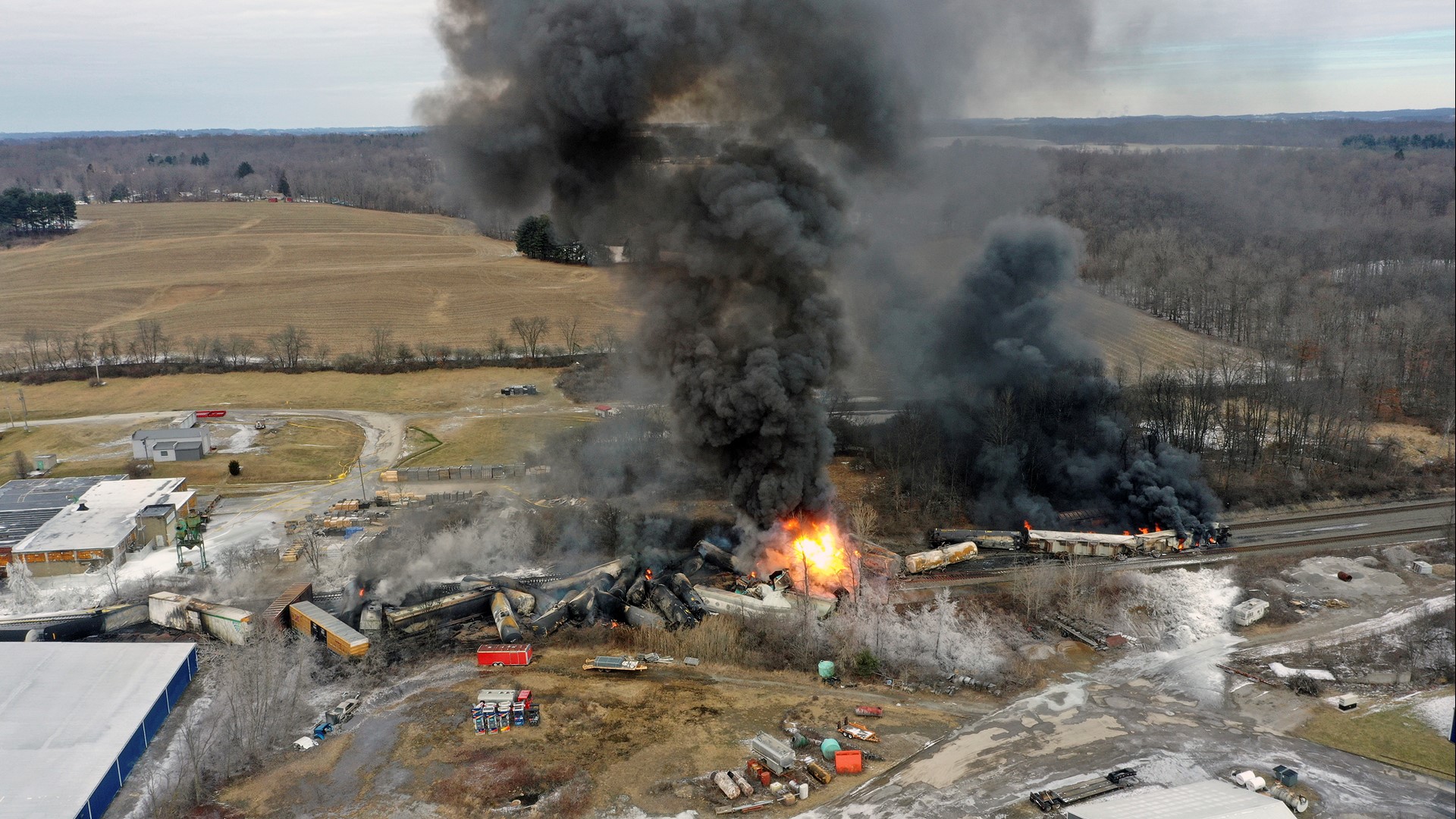Ohio Train Disaster: Prolonged Exposure To Toxic Chemicals In Buildings

Table of Contents
Assessing the Scope of Contamination: Mapping Chemical Dispersion in Buildings
The derailment released a cocktail of hazardous substances, including vinyl chloride, butyl acrylate, and other toxic chemicals known for their detrimental effects on human health. These chemicals didn't simply dissipate; they infiltrated the environment, potentially entering buildings through various pathways. Air infiltration, contaminated water supplies, and even the adherence of chemicals to surfaces pose significant risks. Accurately mapping the extent of contamination presents a considerable challenge. The dispersion of these chemicals is influenced by several factors, making it difficult to pinpoint affected areas precisely.
- Methods used to detect chemical contamination: Air sampling utilizes specialized equipment to analyze air quality for the presence of volatile organic compounds (VOCs) like vinyl chloride. Water testing involves analyzing water samples for the presence of contaminants. Soil testing may also be necessary to determine the extent of ground contamination.
- Factors affecting the dispersion of chemicals: Wind patterns played a crucial role in dispersing the plume of toxic chemicals, influencing where contamination is most concentrated. Building materials, particularly porous materials, can absorb and retain these chemicals, leading to prolonged exposure.
- Challenges in accessing and testing all affected buildings: Gaining access to all potentially affected buildings for thorough testing presents a logistical hurdle. Furthermore, the sheer number of buildings in the area makes comprehensive testing a monumental task.
Health Risks Associated with Prolonged Exposure to Toxic Chemicals
Exposure to the chemicals released in the Ohio train derailment poses significant short-term and long-term health risks. The specific dangers depend on the chemical involved and the duration and level of exposure. Vinyl chloride, for example, is a known carcinogen linked to various cancers, including liver cancer. Butyl acrylate can cause respiratory irritation, skin sensitization, and eye irritation. The vulnerability of certain populations, including children, the elderly, and individuals with pre-existing respiratory conditions, is significantly higher.
- Specific health problems linked to vinyl chloride exposure: Liver cancer, brain cancer, lung cancer, and other cancers are strongly associated with vinyl chloride exposure. Other potential health problems include liver damage and circulatory problems.
- Long-term effects of butyl acrylate exposure: While short-term effects are primarily respiratory and skin irritations, prolonged exposure to butyl acrylate may lead to chronic respiratory problems and potential long-term health complications.
- Symptoms to watch for after exposure: Symptoms may include headaches, dizziness, nausea, vomiting, respiratory difficulties (coughing, shortness of breath), skin irritation, and eye irritation. Immediate medical attention is crucial if any of these symptoms occur following potential exposure.
Mitigation and Remediation Strategies: Cleaning Up Contaminated Buildings
Remediation of buildings affected by the Ohio train derailment is a complex process requiring specialized expertise and advanced techniques. The process typically involves several key steps: air purification to remove airborne contaminants, water treatment to ensure the safety of drinking water sources, and removal of contaminated materials, such as flooring, insulation, or other porous materials. Professional remediation is paramount to guarantee the complete removal of toxic chemicals and ensure the safety of building occupants.
- Methods for removing vinyl chloride from air and surfaces: Specialized air filtration systems and techniques like activated carbon adsorption are employed to remove vinyl chloride from the air. Contaminated surfaces may require specialized cleaning or replacement.
- Procedures for decontaminating water supplies: Water supplies need thorough testing and may require treatment methods such as filtration or disinfection to remove any residual chemicals.
- Disposal of contaminated materials following safety regulations: The disposal of contaminated materials must adhere to strict environmental regulations to prevent further contamination and protect public health.
Legal and Regulatory Implications: Holding Parties Accountable
The Ohio train derailment has far-reaching legal and regulatory ramifications. Determining liability for the disaster and ensuring adequate compensation for affected individuals and businesses are critical. Ongoing investigations are underway, and potential lawsuits are expected. Environmental protection regulations are being scrutinized, and their enforcement will play a significant role in preventing future disasters.
- Potential legal avenues for affected residents: Affected residents may explore legal avenues such as class-action lawsuits to seek compensation for medical expenses, property damage, and other losses.
- Regulatory bodies involved in overseeing the cleanup: Agencies like the Environmental Protection Agency (EPA) and the Ohio EPA play critical roles in overseeing the cleanup process and enforcing environmental regulations.
- Current status of legal proceedings: The legal proceedings are ongoing, with various lawsuits and investigations underway to determine liability and ensure accountability.
Conclusion: Understanding the Long-Term Impacts of the Ohio Train Disaster: Protecting Your Health and Home
The Ohio train derailment highlights the devastating consequences of prolonged exposure to toxic chemicals released into the environment. The lingering threat of building contamination underscores the need for proactive measures to protect public health. Professional remediation, ongoing monitoring, and a thorough understanding of potential long-term health effects are crucial. Stay informed about ongoing developments and seek resources for support if you suspect your building may be affected.
If you suspect your building is affected by the Ohio train disaster's chemical release, seek professional assessment for prolonged exposure to toxic chemicals and take appropriate action to protect your health and family. Contact your local health authorities or environmental agencies for guidance and support.

Featured Posts
-
 Wta 1000 Dubai Eliminacion Temprana De Paolini Y Pegula
Apr 27, 2025
Wta 1000 Dubai Eliminacion Temprana De Paolini Y Pegula
Apr 27, 2025 -
 Elina Svitolina Dominates Kalinskaya In Dubai First Round
Apr 27, 2025
Elina Svitolina Dominates Kalinskaya In Dubai First Round
Apr 27, 2025 -
 Chillin In Alaska Ariana Biermanns Romantic Trip
Apr 27, 2025
Chillin In Alaska Ariana Biermanns Romantic Trip
Apr 27, 2025 -
 Your Guide To The Grand National 2025 Runners At Aintree
Apr 27, 2025
Your Guide To The Grand National 2025 Runners At Aintree
Apr 27, 2025 -
 The Likelihood Of A Fifth Champions League Place For The Premier League
Apr 27, 2025
The Likelihood Of A Fifth Champions League Place For The Premier League
Apr 27, 2025
